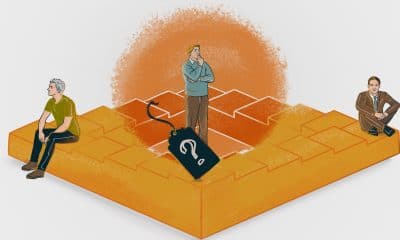AH, YOU’RE BACK… Where were we? If you recall, my last column looked at how the typical person learns how to screen print:
- They were self-taught.
- They were taught by the guy leaving.
- They took a seminar or short training course.
This month, we’ll look at #4: Learning through a structured training program/apprenticeship at a company run by skilled personnel.
I know one printer who was not just a proponent of structured training, but put it into practice. Bron Wolff was production manager at some of the largest screen printing operations in the US, and instituted training programs at a number of plants in which he worked. He taught at SGIA and is a member of the Academy of Screen and Digital Printing Technologies (ASDPT). He’s an avid art and history buff, a Navy veteran, and shoots “high power and black powder.” Whether he’s carrying a musket or a densitometer, you listen when Bron speaks.
“I worked in several large plants with multiple UV in-lines printing small and large format,” he says. “We printed halftones up to and including 172 lpi. We printed 127 lpi fairly often. We printed probably 95 percent four-color process or vignettes, or simulated process jobs. Some ‘Eat at Joe’s’ type signs, but those were a small percentage of our work. We had several training programs in plant, and yes, they were written programs. One plant had a book they gave to all press operators and new hires. We had one for project managers in the office as well.”
Bron made the manuals process- and machine-specific – details about running each machine were separate, so personnel were cross-trained on all the different presses. Some of the press operators were trained to use CTS units as well.
Instruction was semiformal in small classes, with usually one or two crews at a time from all shifts. Bron talked and demonstrated press setup, registration, substrate variability, stability, etc. during these sessions. And he used a concept I love on how to learn from mistakes.
Advertisement
“We were big on density and dot gain, color control, management, and sustainability,” he explains. “Had a big sheet on press setups. I think it had nine things listed: Do this first, etc. and if none of them work to get you in color, then it’s probably not a press issue. It was called Fail Fast, or rather, Fix Fast – and move on. I reinforced this during press setups, approvals, etc. If we had a problem job, they all saw it – what the problem was, why it happened, and how to fix it and not repeat it. My plants always had the fewest problems with matching and holding color. It was different, but it worked.”
If in-plant training works well, then why don’t we see more of it? Says Bron, “I keep telling people there is a hell of a lot of difference between 10 years’ experience, and one year of experience 10 times. But that seems to be the norm in this industry. Upper management and ownership is where a lot of the problems and resistance to training occurs. I used my down time to train. I would watch my schedules and when we had gaps, fill them in with training. The big shots want to send everyone home or sweep floors so the place looks pretty.”
“In ‘nam [Vietnam], we learned combat tactics and combat shooting before we got into it so once we did get shot at, what we were trained to do became second nature. In business, sometimes, they don’t see the benefit of this.”
Bron explains the nuts and bolts of the training program. They had what they called “ladders.” In printing operations, the ladders had three rungs, or tiers, defined by lists of what the employees should know and be proficient at. Pay was based on that level of knowledge and the tasks they performed.
The first rung was Beginning Operator, and the list contained things like setups, paperwork, squeegee care and sharpening, etc. Tier two was more complex and included, along with operating the machines, the use of the densitometers and reading for dot density and gain. The paperwork was more complex. This level also included some ink mixing and provided a raise.
Employees working at the top of the ladder used UV radiometers and spectrophotometers, made color adjustments, etc. Once again, attaining the third tier included a pay increase. Bron recalls operators who had been there for years and never made it past level one. And they had new hires who, after a couple of years, were at level three. He told them right from the start that if they ever did a layoff, they were keeping the third tier people; seniority had nothing to do with it. “The best printers were all drive and desire – as usual.”
Advertisement
Bron recently “un-retired.” After moving to northern Indiana, he applied for a part-time job at a T-shirt shop. This quickly morphed into a full-time job, with him running the shop.
“They’re typical, taught from within with ‘best practice’ being what someone else told them.” (See industry training method #2.) “I’ve been showing them, from the technical side, from the training side, how what they do falls short of the mark. Last week, my third week here, we did a fairly nice 1954 Studebaker print with a five-color simulated process and you would have thought they struck gold.
“The two things that are toughest on people are public speaking and change. Comes down to what you want to get, and where you want to go. [The] place I’m at wants to run with the big dogs: They need to learn, and change.”
Read more from Andy MacDougall.

 Case Studies2 months ago
Case Studies2 months ago
 Art, Ad, or Alchemy2 months ago
Art, Ad, or Alchemy2 months ago
 Andy MacDougall2 months ago
Andy MacDougall2 months ago
 Columns3 weeks ago
Columns3 weeks ago
 Editor's Note2 weeks ago
Editor's Note2 weeks ago
 Marshall Atkinson2 weeks ago
Marshall Atkinson2 weeks ago
 Thomas Trimingham2 months ago
Thomas Trimingham2 months ago
 News & Trends2 months ago
News & Trends2 months ago

















